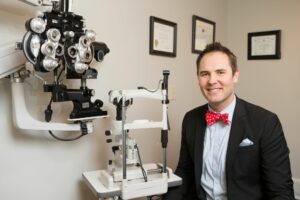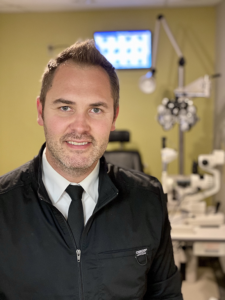
Dr. Kading in one of his exam rooms. Dr. Kading says NaturalVue ® Enhanced Multifocal 1 Day Contact Lens is an important part of many of his patients’ myopia management treatment plans.
A daily disposable soft multifocal contact lens that could be exactly what many of your patients need.
Sponsored Content
David L. Kading, OD
March 13, 2024
The uncontrolled progression of myopia comes with many negative consequences for patients, ranging from the simple inconvenience of not being able to see without glasses or contact lenses to the higher risk of developing sight-threatening conditions later in life.
In our practice, which has hundreds of myopia management patients, and is a referral center for myopia management, it’s important to have many solutions available for our patients.
We Utilize All Treatments at Our Disposal
In our practice, we utilize all currently available treatments. We feel it’s important not to be a “one-trick pony,” but to have resources for patients who need various treatment types.
Some parents do not want to manage their child wearing lenses at school, or the child may be an active swimmer, in which case we select orthokeratology. Some parents feel their child is too young for contact lenses in which case we select atropine. While some do best wearing a soft multifocal lens, we feel comfortable having patients in all of those modalities and may switch between or combine them in order to maximize the “myopic dose” that a patient needs.
The things we love about multifocal soft lenses are that they are easy to care for; parents have often worn them themselves and it seems like less of a burden for them to have their child wear them. The lenses we have today are comfortable and have been worn successfully by patients in our office and around the world.
The information in our office about the success of contact lenses, and other myopia management treatments, in slowing down the progression of myopia, appears to align with the studies. But the important thing to remember as clinicians is we don’t always want to target what the studies are showing. Instead, we advocate for actively managing the myopia in your patients using all the tools to minimize the progression.
An Outstanding Tool in our Myopia Management Tool Chest
One of the daily disposable soft multifocal lenses we use in our office for myopia management is NaturalVue ® Enhanced Multifocal 1 Day Contact Lens from VTI. Recently presented data from their PROTECT RCT showed that within a one-year data set, 45 percent of kids in the study showed no myopia progression, and two-thirds, or 64 percent, had no meaningful progression (quarter of a diopter or less of progression.) The average refractive error reduction was 71 percent (or 0.41 D) versus the control group in that first year. We think that’s really awesome.
In addition, the children wearing NaturalVue lenses for one year showed an average refractive error change of 0.17 diopters. It may not work that way for every patient, but that helps give us confidence in prescribing this lens.
As a clinician who focuses on axial length, I was happy to see that the average axial length reduction of patients in the study was 0.17 millimeters, a 61 percent reduction, versus the control group. The average axial length change was 0.11 mm for children wearing the NaturalVue lens.
Those numbers are helpful to show that we are slowing both the progression of refractive error, and axial length change.
An Effective & Safe Option for Children
Studies suggest that with higher amounts of higher-order aberrations, patients’ refractive error and axial length may not progress as much. It seems that having a conflicting data point hitting the visual system may be helpful in slowing down the elongation of the eye. We think NaturalVue’s peripheral defocus is key to its efficacy and may be, in part, what is helping to slow the progression in the patients observed in the PROTECT Study.
Children tend to do very well with most contact lenses. They usually don’t have preconceived notions about what contacts should feel like. They tend to have a good tear film, so most treatment options, including soft multifocals, will work effectively for young patients.
Impress on Parents the Importance of Myopia Management
We start off in our presentation to parents with the obvious point that their child’s prescription keeps getting worse. I might say: “Your child’s eyes are stretching which has caused their prescription to change since we saw them last. Obviously, we want to update their prescription so they can see better and function better, but because it is increasing and the eye is stretching, we want to see if we can find a way to slow it down, so it doesn’t do this at the same rate in years to come.”
We also talk about how the higher the prescription becomes, the more difficult it will be in the future for their child to go without glasses or contact lenses. We note that there may be fewer options available for them for correction with LASIK or contact lenses, and that they may need thicker glasses. But we always start the conversation with the focus on seeing well and having better quality of life.
Other Articles to Explore
I also bring up that as eyecare doctors, we see that eyeballs with higher prescriptions tend to be getting that way because the eyeballs are stretching. That stretching effect on the tissue puts the eyeballs at a greater risk for other diseases, not now, but as their child ages and goes into adulthood. “We want to keep that prescription small so they can function better, but we also want to keep the eyeball from stretching so it stays healthy as they become adults.”
Myopia Management: Future Focus
To make a true dent in the myopia pandemic and the incoming diseases caused by myopia (glaucoma, macular disease and retinal pathology) we need to get more clinics involved in myopia management. We have hundreds of myopia management patients in our practice, but every practice needs to be getting on the same page about myopia management.
The great thing about soft multifocals is practitioners are already fitting them, so there’s not a big hurdle to start doing it. Soft multifocal modalities offer a low barrier to entry for practices.
Soft multifocals are a great starting point for many patients. It is sometimes all that is needed to slow the progression of myopia for a patient and help them lead a life with sharper vision and healthier eyes.
 David L. Kading, OD, is a partner with Specialty Eye, which has three locations in Bellevue, Kirkland and Seattle, Wash. To contact him: Drdave@specialtyeye.com
David L. Kading, OD, is a partner with Specialty Eye, which has three locations in Bellevue, Kirkland and Seattle, Wash. To contact him: Drdave@specialtyeye.com
Disclaimer: Dr. Kading was compensated for his time in preparing this article.
Note: This information reflects the 1-year data set. The PROTECT study is ongoing and the data will continue to be reviewed and analyzed with additional details to be shared as available. NaturalVue® Multifocal is part of an ongoing clinical trial (RCT) that is studying its effectiveness for myopia progression control.
This information may describe uses for this product, i.e., Myopia Progression Control, which have not been approved by the FDA for use in the United States and is intended for educational purposes only.
VTI-RCT-AP3

























